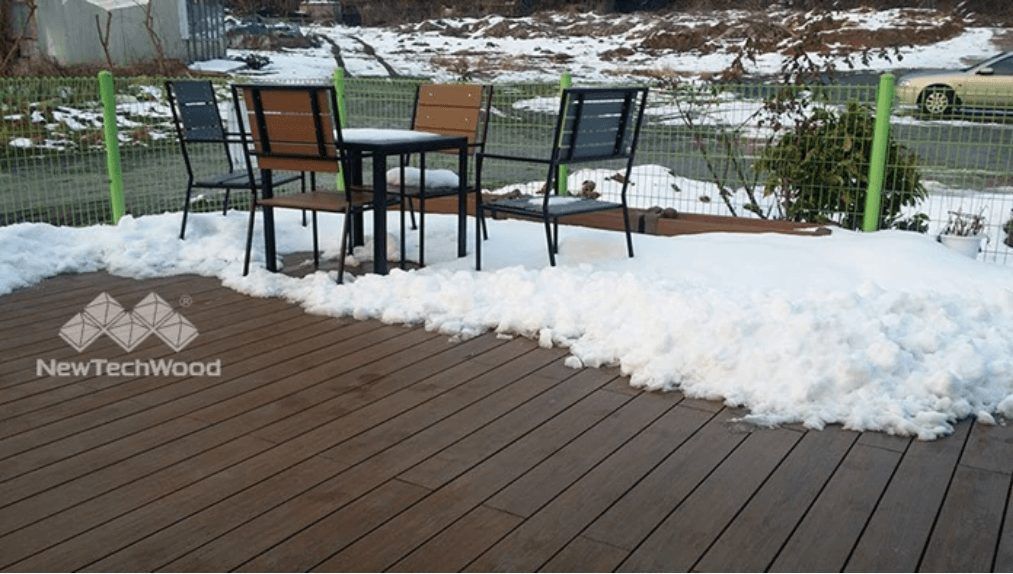
THE BEST DECKING FOR WINTER WEATHER
For the majority of the year, your deck is the perfect place for entertaining, cooking and spending time outdoors. In the winter, however, this may no longer be the case. In areas that experience snow and frigid temperatures, decks may be inaccessible. Winter conditions, like snow and ice, also have the potential to damage decks.
Fortunately, composite decking is much more durable and easier to care for in the winter than traditional wood.
WHAT KIND OF DECKING IS BEST FOR WINTER?
If you live in an area that experiences harsh weather conditions, you might be wondering which deck holds up best to winter weather. Unlike traditional decks, composite decking is designed to withstand the moisture, cold temperatures and sunlight exposure that come with winter weather. Unlike wood decking, composite decking does not:
- Require excessive winterization or preparation.
- Warp or split in the cold temperatures.
- Rot or soften from excess moisture, snow or ice.
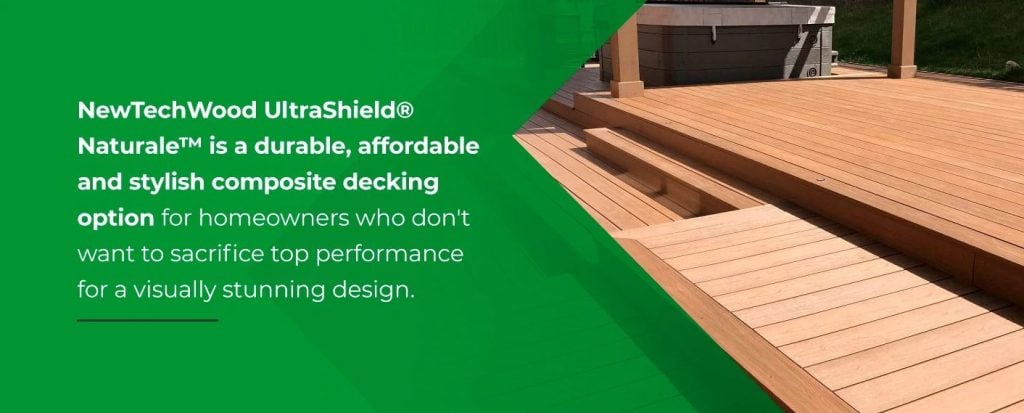
NewTechWood UltraShield® Naturale™ is a durable, affordable and stylish composite decking option for homeowners who don’t want to sacrifice top performance for a visually stunning design. UltraShield® Naturale™ composite decking is available in colors and finishes that mimic natural wood.
NewTechWood Naturale™ deck boards are available in the following wood finishes:
- Peruvian teak
- Brazilian ipe
- Spanish walnut
- Hawaiian charcoal
- Westminster gray
- Roman antique
If your project meets a few specifications, we also offer custom colors and profiles to help you achieve the exact look you want for your outdoor space. Some bold, tropical color options customers have chosen in the past include:
- California redwood
- Floridian orange
- English oak
- Irish green
- Swedish red
- Caribbean blue
- Mahogany
- Australian red cedar
- Indonesian merbau
In addition to wood and tropical finishes, we also have composite decking tiles available that look like grass or stone. All our composite decking is compatible with one another, so you can come up with a design that is uniquely yours. For project inspiration, visit our online photo gallery to see what past satisfied customers have done with their composite decks.
See the Difference for Yourself
To provide our consumers with tangible proof of the benefits of composite decking over conventional decking materials, NewTechWood conducted a series of comparison tests. We tested our UltraShield® composite material against traditional decking and found it superior in the following ways, including:
- Stain, abrasion and scratch resistance.
- Fading or warping due to UV exposure.
- Durability when met with boiling water.
WHY DOES COMPOSITE DECKING HOLD UP WELL IN WINTER?

Composite wood is made of a combination of wood fibers and high-density recycled polyethylene plastic materials. NewTechWood then finishes each composite decking board or tile with a strong polymer protective coating. Because of this, composite decking is stronger and more durable than wood or plastic alone. It is the ideal decking choice for anyone who wants longevity and minimal upkeep or repair after a harsh winter season.
Composite decking holds up so well in winter weather because it is:
Easy to Install
NewTechWood UltraShield® composite decking boards are simple to install yourself, making them the ideal choice for any busy homeowner. To install our composite decking boards, all you have to do is:
- Locate a flat surface on which you want to install your deck. Never apply decking tiles directly on grass, sand or other unstable surfaces. However, you can apply composite decking boards onto pre-existing concrete or patios.
- Build a solid substructure with properly spaced joists to lay your composite decking on. If installing composite decking over a pre-existing porch, make sure all joists and substructure components are structurally sound and spaced according to our installation guide.
- Allow decking to acclimate on a flat, solid surface for a minimum of two days before beginning the installation process.
- Plan the pattern or design you want to achieve with your composite decking. If using multiple colors or finishes, consider drawing a detailed design on paper, so you can consult it throughout the installation process.
- Use clips to attach and snap composite decking into place according to your design.
- Attach any end caps, plus any railings or fascia to your decking.
- Seal any cut areas of your decking boards with end caps or a water-resistant sealant to prevent water from seeping inside.
You can view a complete installation guide on our website, or watch one of our UltraShield® Naturale™ installation videos for a visual demonstration.
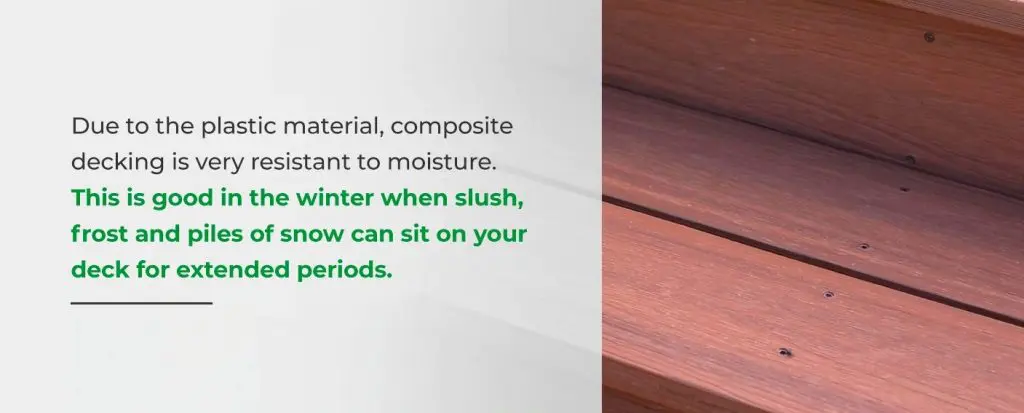
Moisture Resistant
Due to the plastic material, composite decking is very resistant to moisture. This is good in the winter when slush, frost and piles of snow can sit on your deck for extended periods. With composite decking, you do not have to worry about the moisture seeping into the material and causing rot or warping. Once temperatures warm up and snow melts, composite decking also dries quickly. The quicker water dries, the less time it has to refreeze.
Mold and Mildew Resistant
UltraShield® composite decking has a layer of protection that keeps the core of your decking boards safe from mold or mildew, which can break traditional decks down over time. With our fully capped composite decking, you never have to worry about the integrity of your boards.
Resistant to Warping, Splintering and Splitting
Unlike some composite decking, NewTechWood UltraShield® is capped on all sides, providing a superior layer of protection. Non-capped or partially capped composite decking is more likely to split, fade, mold or crumble. Our fully capped decking keeps your composite deck from splitting, warping or splintering on the surface, even during constant UV ray exposure or inclement weather. This extends the lifespan of your deck and ensures a comfortable outdoor experience.
Stable
All wood decks naturally expand and shrink over time due to humidity and moisture. Composite decking is stable during extreme temperatures and weather conditions. Unlike traditional decking, composite decking is far less likely to expand, shrink or shift over time.
Easy to Maintain
Composite decking is virtually maintenance-free. It is designed to last decades without needing to be repaired or replaced. However, for superior results, there are a few things you can do to get the most out of your composite decking:
- Wash your deck occasionally or when needed, including under mats and furniture.
- If you spill food, oil or another abrasive substance on your deck, promptly remove it and clean the area.
- Keep your deck free of all standing water.
- Do not use harsh cleaners, abrasive tools or high-pressure washers on your deck.
- Regularly inspect your decking for signs of change.
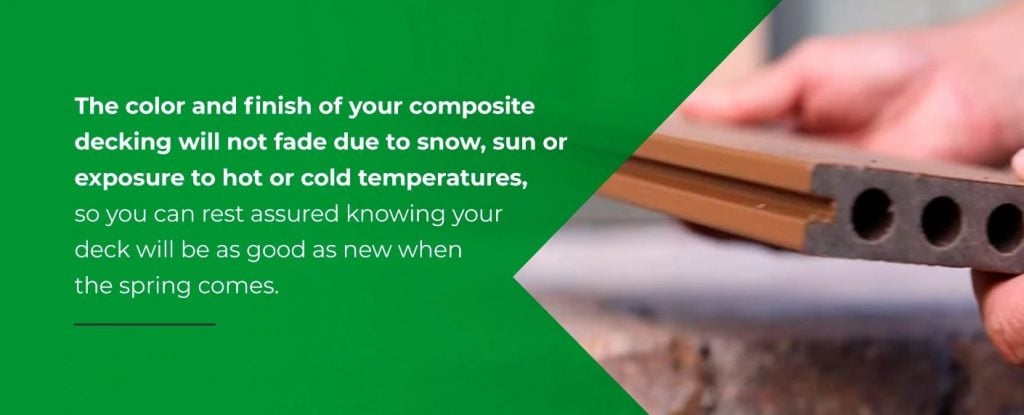
Long-Lasting
The color and finish of your composite decking will not fade due to snow, sun or exposure to hot or cold temperatures, so you can rest assured knowing your deck will be as good as new when the spring comes.
Due to the unique protective UltraShield® finish, you will notice very little change in the color of your deck over the years. With NewTechWood UltraShield® technology, you never have to worry about staining, sanding or oiling your deck again.
NEWTECHWOOD COMPOSITE DECKING IS BETTER FOR THE ENVIRONMENT
NewTechWood is committed to producing responsible and sustainable composite materials. As a company, some of the ways we “think green” include:
- Using high-quality recycled plastic materials in all our composite decking boards, tiles, railing, siding, bird feeders, deck fasteners, planter boxes and more.
- Annual third-party audits to ensure our company is complying with all environmental, health and safety regulations.
- Active and ongoing waste reduction and energy conservation efforts.
- A hands-on recycling process — including washing, sorting and processing — which allows us to control every part of our final product.
We are proud to report that each month, our efforts have allowed NewTechWood to save over 12 million pounds of plastic from landfills. When you choose NewTechWood as your composite deck supplier, you are choosing a greener home.

SHOULD I COVER MY DECK IN THE WINTER?
You do not have to cover your deck to keep it safe during the winter — composite decking is durable and can withstand most wintery conditions. However, if covering your deck gives you peace of mind, here are a few guidelines to follow:

- Pick the right tarp: Avoid fabric or cloth-based tarps, as they are not waterproof and can harbor mold and bacteria when wet. Instead, choose a waterproof tarp made of vinyl or polyester. Consider sealing your tarp with a water-repellant coating for even more protection.
- Secure it: When laying your tarp, make sure it is flat against your deck. Secure it evenly with ties or tarp clips. To keep the tarp laying flat against your deck in high winds or heavy rain, weigh it down with bricks, stones or cinderblocks — just be careful not to drag heavy blocks across your composite decking.
- Avoid any gaps: Do not leave any gaps between the tarp and your deck, as this will allow water to collect and pool underneath.
- Do not neglect your tarp: Maintain your covered deck the same way you would if the tarp were not present. Brush the snow away whenever possible and do not allow standing water to collect and freeze.
- Remove the tarp promptly: Remove the tarp once winter is over and allow it ample time to dry before storing it away for next year.
- Play it safe: Never cover your composite decking with wood planks, stones or other abrasive and heavy materials.
HOW TO PREPARE YOUR DECK FOR WINTER
While composite decking is durable, there are some steps you should take to prepare your decking for winter weather, such as:
Inspect Your Decking
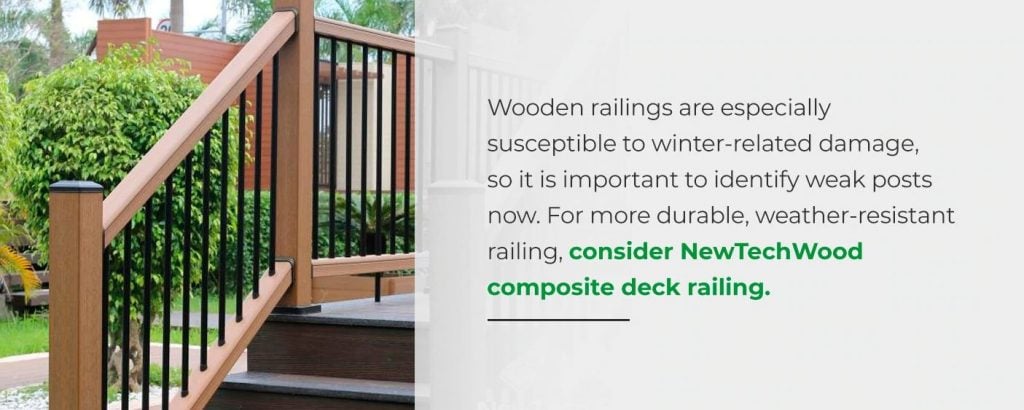
Before winter comes, check your decking to identify any areas of concern. Take note of the following areas:
- Railing: Inspect all parts of your railing, including each individual post. Wooden railings are especially susceptible to winter-related damage, so it is important to identify weak posts now. For more durable, weather-resistant railing, consider NewTechWood composite deck railing. Like composite decking, composite deck railings do not fade, warp or mold over time.
- Stairs: If you have wooden stairs with your composite decking, you must take the necessary steps to winterize them. This includes applying a water-resistant sealant and covering them before snow or rain, if possible.
- Deck tiles: Inspect individual decking boards or tiles for any abnormalities, standing water, stains or other areas that need to be addressed before winter.
- Cracks and gaps: Make sure all cracks and gaps between decking boards, railings and stairs are free of debris or buildup.
- Foundation: Check all foundation and deck supports for any weak spots, including holes, soft wood, cracks or other damage.
- Joists: Check that all wooden joists are fully intact and that all screws or nails are securely in place.
Should you notice any weak parts of your deck, make the necessary repairs before winter arrives, as winter conditions can worsen vulnerabilities.
Prepare Your Deck
Once you have inspected your deck and made any required repairs, it is time to prepare your deck for winter — to do this:
- Remove furniture and decor: Remove any rugs, deck furniture, pots, planters, lighting or other decorative items that are not waterproof or weather-safe. Many items, especially rugs, can leave markings if left in the same spot on your deck all season long, due to the moisture that naturally collects underneath. For items you cannot move — especially wooden furniture or planters — consider covering them with a waterproof protectant or tarp.
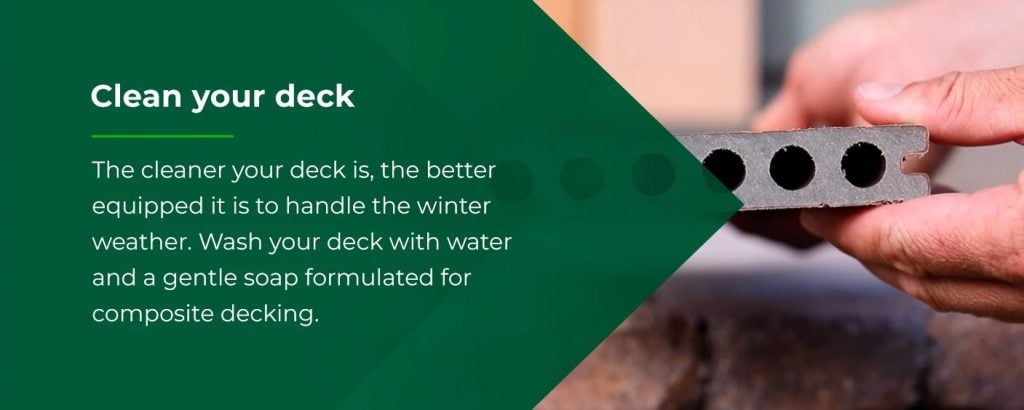
- Clean your deck: The cleaner your deck is, the better equipped it is to handle the winter weather. Wash your deck with water and a gentle soap formulated for composite decking. Don’t forget to clean any gaps in your deck and dislodge all built-up debris. Never use abrasive cleaners or cleaning tools on your deck. If you must power wash, do so on a low setting.
- Apply a sealer: Is composite decking good in winter conditions? Yes — but you should still consider adding a water-based sealant formulated for composite materials to your deck. During the winter, there may be times when you are unable to remove snow or ice from your deck due to ongoing weather conditions or hazardous temperatures. A sealant can help add an extra layer of protection for any vulnerable areas against moisture damage. After cleaning your deck and allowing it to dry thoroughly, apply the sealant. Do so in plenty of time before winter, so it has time to dry and set.
Choose Weather-Safe Deck Furniture
If you lack the necessary storage space to put your deck furniture or decor in during the winter, consider choosing water-resistant chairs, tables and planter boxes:
- Tables: Avoid choosing outdoor tables constructed with unprotected wood or glass. Instead, consider powder-coated aluminum, resin wicker, wrought iron or steel. These materials are less susceptible to rust, fading, rot and mold growth.
- Seating: Choose your deck chairs in the same durable materials. If opting for pillows or seat cushions, choose ones made with acrylic or polyester fabric. Always remember to bring pillows and cushions indoors before strong winds or rain.

- Planter boxes: Worried about your outdoor planter boxes lasting through the winter? NewTechWood offers planter boxes made with our durable composite material in both teak and cedar wood finishes. Our composite planter boxes are easy to install yourself and will remain intact during winter weather. When you’re ready to plant in the spring, our boxes will keep all sand and soil in while still allowing water to drain.
- Bird feeders: Is there anything prettier than birds in the snow? Enjoy the view all season long with composite bird feeders from NewTechWood. Available in several styles and designs, our composite bird feeders are weather-resistant, just like your decking.
Always bring in any decor that can blow away in heavy wind or easily rust, such as wind chimes, watering cans or other metal fixtures.
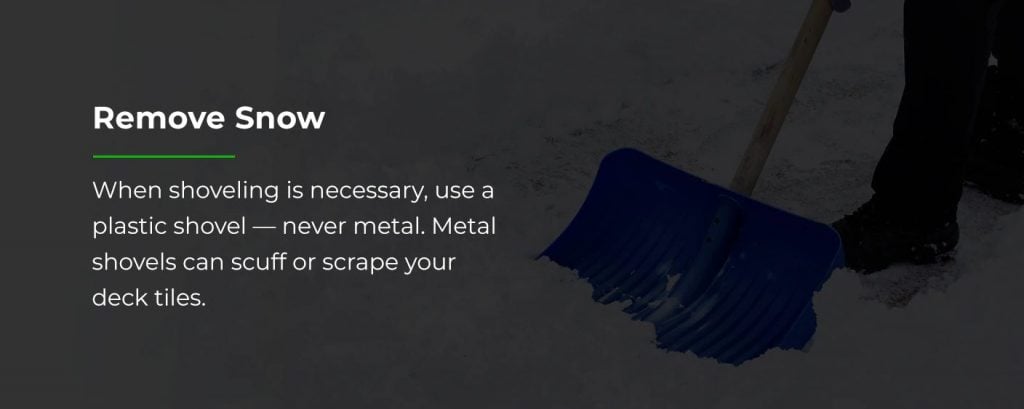
Remove Snow
Composite decking is designed to withstand snow. However, if you want to know how to protect a deck in the winter, it never hurts to remove snow for safety purposes and to help your decking last even longer. Instead of shoveling, gently sweep the snow away with an outdoor broom.
This is the best way to preserve the integrity of your decking. However, there may be some circumstances that require shoveling, such as an excessive amount of snow or to create a pathway out of your house. When shoveling is necessary, follow these tips:
- Use a plastic shovel — never metal. Metal shovels can scuff or scrape your deck tiles.
- When shoveling or sweeping, do so parallel to the deck boards to prevent damage.
- Shovel in gentle, even movements, rather than breaking or chopping the ice apart.
Use Ice Melts
Rather than shoveling, use ice melts on your porch whenever possible. Do not use sand or sand-based ice melts, as the particles can scratch the surface of your tiles or become lodged in any gaps. Use an ice-melt that is designated as safe for composite decking.
A calcium chloride ice melt is ideal, as it is easy to use and safe for your deck. Be careful when applying salt or salt-based ice melts, as the salt can leave a residue behind after extended exposure. If you use an ice-melt, remember to wash away any remaining residue when the temperature warms to prevent stains or corrosive behavior.
Check for Damage
Once winter is over, it is time to reinspect your deck. Perform another visual inspection of all parts of your deck, taking note of any changes that need to be addressed. If you made any repairs on your deck before winter, inspect those areas and make sure they are still in-tact or if further work is needed. Pay special attention to wooden parts of your deck, such as the joists, railing posts or stairway, as non-composite components are more susceptible to damage.
Here are some signs that may indicate damage:
- Squeaking or bouncing when walking across your deck.
- Rusted or corroded nails and screws.
- Sagging or cracks in the joists.
- Warped, wiggling or loose rail posts.
- Squeaking sounds or a sinking sensation when walking on wooden stairs.
If you notice any of these issues, contact a professional contractor to take a look. Never ignore or put off repairs to your deck, joists, railing or stairway, as they can worsen over time, leaving you with a more costly and challenging repair process.
Perform Spring Cleaning
After you have finished your post-winter deck inspection, it’s time for some spring cleaning. Wash away all ice-melt residue and eliminate all standing water left from snow or ice. Re-wash your deck if desired. Once your deck is clean and dry, you may replace all furniture, pots, planters, lighting and decorations.
IS COMPOSITE DECKING SLIPPERY IN WINTER?
If you are concerned about gaining traction on your composite deck, consider choosing a textured or grooved decking tile, as they provide more of a grip than smooth surface decking. Regular cleaning with soap and water throughout the year will help prevent algae from growing, which is often responsible for slippery decks.
To minimize hazardous ice on your deck, do not allow standing water to collect and pool. For your safety, you should also make sure your deck railing is strong enough to support you or a loved one in the event of a fall.

YOUR DECK AND WINTER PESTS
Moisture and ice are obvious threats to your home in the winter — but don’t forget about winter pests. As the temperatures drop, many insects and rodents — including mice, squirrels, ants, spiders and flies — may try to make their way into your home. Once inside, insects can wreak havoc on your belongings, eat away at your walls and floors, contaminate food and even spread disease.
One way insects and rodents may enter your home is through your deck. Here are some steps you can take to safeguard your deck and your home from a winter pest invasion:
- Be mindful of firewood: If you are among the many homeowners that use firewood throughout the winter to warm their house, be cautious when storing it. If you store a pile of firewood on your deck, insects, rodents and spiders who have created a nest in the wood will have an easier time entering your home. For your protection, store firewood at least 20 feet from your house.
- Secure the underbelly: Rodents and insects may try to create shelter underneath your deck. To prevent this from happening, remove any clutter or debris around and beneath your deck, as rodents use clutter to hide and burrow. Make sure the area beneath your deck is properly ventilated, as damp, dark areas can attract bugs.
- Protect your trash: Be careful where you store your trash cans. Although keeping your trash can on the deck may be convenient, the smell of food and waste in your garbage will draw pests near and encourage them to stay.
- Consult the professionals: If you suspect your deck may attract or harbor winter pests, consult a professional pest service to help you remove the problem and seal your house.
- Seal the entryway: Thoroughly seal and insulate any entryway between your deck and your house, including doors and windows. Insects can crawl in through even the smallest gaps.
ADDITIONAL TIPS FOR KEEPING YOUR DECK SAFE THIS WINTER
Beyond preparation and winter pest control, there are a few other things you can do to protect your deck this season, like:
Remove Hazardous Tree Limbs
If you have trees growing near your deck, take time to examine the limbs before winter, and remove any weak ones. Weak tree limbs can snap off during cold temperatures or under the weight of snow. If the trees are near your porch, a broken branch could result in significant damage to your deck.
To check your tree for signs of decay, inspect the following areas:
- Base: Examine the base of your tree. Look for signs of decay, like holes, missing bark, fungal growth or soft spots. These are all signs of internal rot.
- Trunk: Check the tree trunk for any visible wounds — often caused by landscaping tools or rodents — including gashes, cankers and missing bark.
- Limbs: From the ground, visually inspect tree limbs for missing bark, dead or discolored leaves or fungal growth.
If you suspect your tree is dying or think your deck may be at risk for falling branches, contact a professional to have it removed.
Keep Your Deck Dry
The first step to a dry deck is prevention. Standing water can be harmful to your deck, especially during freezing temperatures — but did you know water can come from more than rain and snow? Other sources of water to watch for include:
- Gutters or drain spouts that empty onto your deck
- Tree branches with melting snow
- Runoff from your roof
- Uninsulated dryer vents
If you find that one of these is draining water onto your deck, do your best to redirect or reposition it before winter. Once you have corrected the problem, remove any existing standing water with a towel, mop or by using a squeegee to push water off your deck gently.
Watch for Icicles and Ice Dams
Icicles are pretty to look at, but unfortunately, they can be a hazard to you, your home and your deck. When an icicle breaks apart and falls, it can cause damage to anything it lands on if it is sharp or heavy enough. Icicles are also dangerous because they have the ability to form into ice dams.
Ice dams grow on your roof or gutters after icicles and snow melt and refreeze into large masses, or “dams.” These ice dams prevent water from properly draining from your roof, which can lead to costly and extensive damage. As ice dams melt or break apart, excess moisture and weight can also damage your decking.
If icicles or ice dams have formed near your deck, you should:
- Check the upstairs levels: An upstairs that is too warm will encourage ice to melt and flow into gutters, which can refreeze. A cold attic allows ice to settle. Keep your attic or upstairs balanced by ensuring it is well ventilated and has good airflow to prevent icicles from forming.
- Clean up: Clean your gutters before winter arrives to minimize water buildup, which allows icicles and ice dams to form.
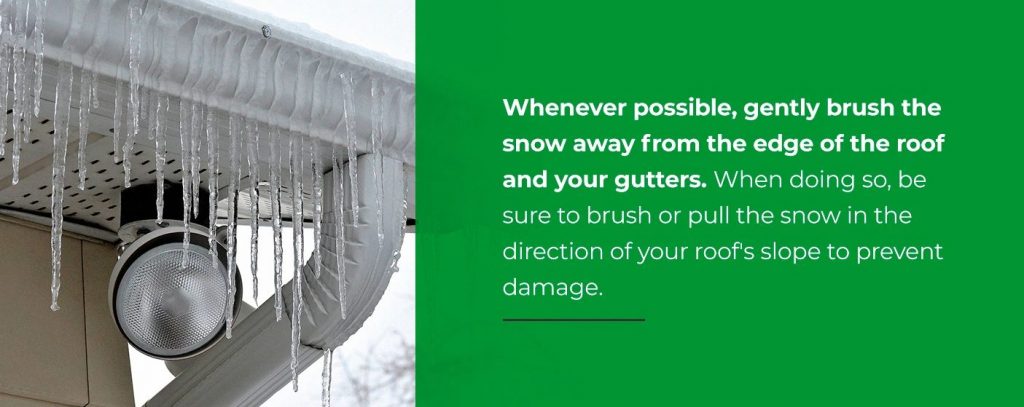
- Keep gutters clear: Whenever possible, gently brush the snow away from the edge of the roof and your gutters. When doing so, be sure to brush or pull the snow in the direction of your roof’s slope to prevent damage.
- Use heat tape: Consider applying heat tape to your gutters, so the snow melts before it has a chance to solidify into hazardous ice. Heat tape is most effective is used preemptively, rather than trying to apply it around icicles and dams.
- Apply ice-melt: Apply an ice-melt to your roof or gutters. Be sure to choose one that is not damaging to composite decking or roofing materials.
- Remove it: Carefully remove small icicles and snow buildup with a roof rake. Never use a shovel or other heavy tools to remove ice or snow from your roof, as you risk puncturing or ripping your shingles.
- Call a professional: Icicles and ice dams are unpredictable and can be dangerous. Do not attempt to remove large icicles or ice dams on your own. Instead, contact a professional contractor.
Provide Adequate Ventilation
Don’t forget about the underneath of your deck this winter. Make sure the underbelly of your deck is receiving adequate airflow and is well ventilated. Otherwise, the buildup of snow and moisture could allow mold or mildew to grow on any non-composite materials in your deck’s foundation.
The best way to ensure adequate ventilation is to install your composite decking properly. NewTechWood recommends placing all composite decking on a framed substructure with a minimum of four inches of ventilation space underneath.
ENJOYING YOUR DECK IN THE WINTER
If you do not live somewhere that gets a lot of snow — or simply want to enjoy time outdoors in spite of it — you have a few options for getting the most out of your deck in cold weather.
- Create an enclosed deck: Many homeowners install a screen or deck cover to enclose their porch. This is ideal for keeping summer mosquitos away, as well as providing a warmer, snow-free outdoor space in the winter. If opting for an enclosed deck, remember to incorporate plenty of ventilation and airflow.
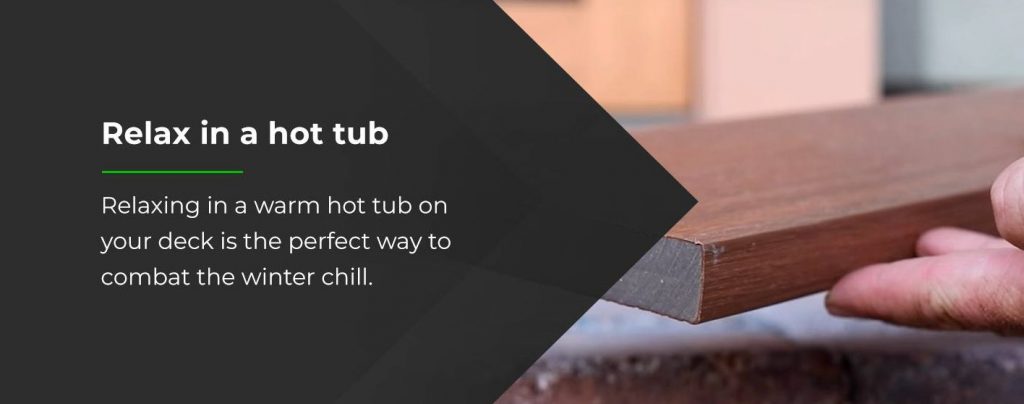
- Relax in a hot tub: Relaxing in a warm hot tub on your deck is the perfect way to combat the winter chill. If you have a hot tub on your composite decking, just be sure to have a strategy in place for minimizing water spillage, as any water that escapes your hot tub will freeze and make your deck even icier.
- Invest in outdoor heating: Consider investing in outdoor heating so you can entertain and spend time on your deck, even in the winter. Outdoor heating keeps you comfortable and can transform your outdoor space into a more welcoming area. A few outdoor heating options include an enclosed fire pit, outdoor fireplace and standalone outdoor heaters.
If you do choose to spend time outdoors this winter, keep a few things in mind for your safety:
- Layer up: Wear plenty of warm layers before spending time outdoors, including a coat, socks, long sleeves, boots, gloves, a hat and a scarf.
- Don’t forget the sunscreen: Extended exposure to the sun’s UV rays can be just as harmful to your body in the winter as in the summer. Stay safe by applying sunscreen before spending time outside.
- Stay dry: Make sure you and your clothes stay as dry as possible outdoors. If your deck has a hot tub, keep towels nearby and go indoors immediately after exiting the water to minimize your chances of getting too cold.
- Know when to head indoors: The key to enjoying your deck in the winter is knowing when it is time to head back inside. Take regular breaks from the winter chill.
HAVE A WORRY-FREE WINTER WITH NEWTECHWOOD COMPOSITE DECKING
NewTechWood UltraShield® composite decking boards and deck tiles eliminate the need to worry about wood rot, color fading, scuffing, scratching, shrinking or expanding. With proper preparation, you can expect your deck to be as good as new when the snow and ice thaw and warm weather returns.
Since 2004, NewTechWood has been a pioneer in the creation and improvement of composite decking boards, deck tiles, siding, deck railing, accessories and more. We are so sure you will love the NewTechWood UltraShield® advantage, that we offer a 25-year limited transferable warranty — one of the most comprehensive warranties in the decking industry.
You can find NewTechWood composite decking in many online and in-store retailers across the United States, including Amazon, Lowes and Home Depot. To find a NewTechWood distributor near you, use our store locator.


